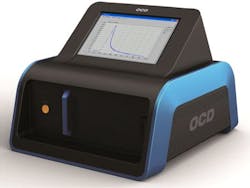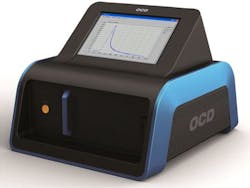Molecular diagnostic device visualizes prostate cancer quickly
Researchers at the Fraunhofer Institute for Ceramic Technologies and Systems (IKTS; Dresden, Germany) have developed a molecular diagnostic device prototype that, based on tissue autofluorescence via activation by a laser pulse, enables visual diagnosis of prostate cancer within a minute and a half. Currently, doctors take a biopsy of prostate tissue from the patient and sends the sample to a lab, which typically takes at least a day.
Related: 'Smart beacons' target cancer tumors
"The physician places the removed tissue sample on a base plate, slides it into the machine, presses a button—and within one and a half minutes, receives a reliable indication of whether the tissue in the sample is benign or malignant," describes Dr. Jörg Opitz, scientist at IKTS. Since the sample does not require a long preparation time and can be pushed directly into the device and analyzed after it has been taken, the patient does not have to wait for days after the biopsy to know the outcome. Results are received immediately, so the doctor can discuss the next steps to take with the patient much sooner.
A further advantage is the reliability of the examinations. "The analyses are based on the autofluorescence that human tissue emits," says Opitz. Fluorophores, which are present in every human body, are illuminated for a very short time when certain light falls on them. If the doctor sets the removed tissue in the device, starts the measurement, emits a dosage of laser pulse, and excites the fluorophores, then the laser pulse stimulates the fluorescent molecules in the tissue to release light. The way in which this fluorescence radiation decreases differs between benign and malignant tissue. The scientists have been able to determine a clear threshold for this different behavior: If the value of the tissue sample exceeds the threshold value, carcinoma is present. Thus, the doctors obtain a clear and unambiguous prognosis. The analysis proceeds automatically. The device shows the physician if the collected sample contains cancer tissue like the colors of a traffic signal.
Currently, the device can only be used for prostate cancer since the threshold value of the unit only applies to this tissue. Each tissue type has a fixed value, but they are different. Prostate tissue has a different value than tissue from the chest or oral cavity. The researchers’ goal is to determine the threshold values for other tissue types and to integrate them into the analysis software of the device. Then, the doctors will be able to examine different samples with the device: They would only need to enter the appropriate tissue type from a drop-down menu.
The molecular diagnostic device has already completed its first two clinical studies, and a third study is currently underway.
-----
Follow us on Twitter, 'like' us on Facebook, connect with us on Google+, and join our group on LinkedIn
Subscribe now to BioOptics World magazine; it's free!

